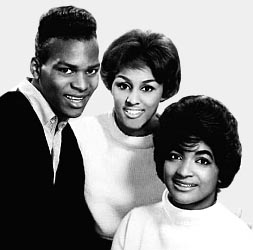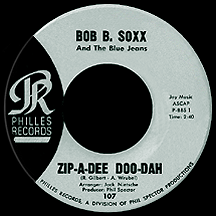BOB B. SOXX AND
THE BLUE JEANS
Zip-A-Dee Doo-Dah
Phil Spector really started coming on strong in 1962. His recently-formed Philles label had two hits by The Crystals to its credit, but it was Darlene Wright, Fanita James and Gloria Jones of established group The Blossoms, along with male singer Bobby Sheen, who supplied the vocals for the company's first number one hit, "He's a Rebel." Because the actual Crystals, with lead singer Barbara Alston, were touring and unable to come to Los Angeles on short notice, and aware of a competing version Snuff Garrett of Liberty was preparing with singer Vikki Carr, Phil had to work fast. To the bewilderment of the vocalists involved, the Crystals got the credit and few knew the difference. Spector, seeing himself as the real star anyway, realized he could mix and match singers and release records under any name he felt would serve his purpose.
In August '62, six weeks after the session for "He's a Rebel" with its rise to the top still several weeks away, Spector decided he was going to remake "Zip-A-Dee Doo-Dah," from the 1947 Walt Disney film Song of the South. Up to this point he had worked with contemporary songwriters (Barry Mann and Cynthia Weil, Gene Pitney) but his unpredictable nature would become more obvious as time progressed. Songwriters Allie Wrubel and Ray Gilbert had won a Best Song Academy Award for "Zip-A-Dee Doo-Dah," sung in the film by James Baskett (in his role as Uncle Remus). Three versions hit the charts in late '47 and early '48: Johnny Mercer's hit first and releases by Sammy Kaye with the Three Kaydets and The Modernaires with Paula Kelly followed. 15 years later, Spector's interpretation of the song turned out to be the most successful version.
The original Blossoms were called The Dreamers when Fanita Barrett (later James), Gloria Jones (not to be confused with the same singer of '60s "Tainted Love" fame) and four others started the group at L.A.'s Fremont High School in the mid-'50s. They did some backup singing for Richard Berry (credited on two of his Flair Records singles) and had one release of their own in 1956 on the Flip label. After changing the group's name, three Capitol singles followed in '57 and '58. Darlene Wright joined, others left, and in the early '60s the group was set with Fanita, Gloria and Darlene. By the time they began doing backup work for Spector, only one single had made a showing on the charts, in May 1961: "Son-In-Law," on the Challenge label, an answer to Ernie K-Doe's chart-topper "Mother-In-Law." In addition to their session work for Philles, they backed up many artists on sessions in the early- to mid-'60s, including Duane Eddy (with whom they were billed as The Rebelettes) and Herb Alpert's Tijuana Brass.

When he was a child, Bobby Sheen's family moved from St. Louis to the same neighborhood in Los Angeles where Phil Spector grew up. He broke into the music business during his teens, touring with The Robins in the late 1950s. Recording for Liberty Records in 1962, he hooked up with Spector (nearing the end of his time as head of A&R for the label) and the result was "How Many Nights (How Many Days)." While not a hit, Spector liked Sheen and hired him soon after for session work at Philles. With "Zip-A-Dee Doo-Dah," he became the unofficial leader of Bob B. Soxx and the Blue Jeans, a name Spector made up (without consulting anyone, least of all the singers involved). While it was hard to imagine a rock and roll reading of lyrics like '...my oh my what a wonderful day, plenty of sunshine headin' my way...,' once finished, everyone involved felt it would be a hit. Bobby, Fanita and Darlene's vocals gave the song a soulful spin that would have been unforeseeable in 1947. As an added bonus, the microphone was turned off for Billy Strange's guitar solo but the other mics in the room picked it up, resulting in a distant, fuzzy sound; a bizarre element that added to the uniqueness of the recording.
The song hit the charts in mid-November and was top ten by year's end. Spector's singers became increasingly confused as the results of sessions weren't necessarily released under the expected, or seemingly logical, names. Phil signed Wright to a contract as a solo singer and changed her name to Darlene Love, but when "He's Sure the Boy I Love," featuring her lead vocal with the same basic Bob B. Soxx lineup, was released as a Crystals record, it became more a point of frustration than anything else. "Why Do Lovers Break Each Other's Heart?" came out as Bob B. Soxx and the Blue Jeans (and reached the top 40) after "Zip-A-Dee" had peaked and, to Darlene's delight, "(Today I Met) The Boy I'm Gonna Marry" was the first release under her new name. A third and final Soxx single, "Not Too Young to Get Married" (addressing the age-old mother-versus-daughter debate on the subject of young love), came out at the beginning of summer. Two Darlene Love solo singles (that could have just as easily been credited to the Crystals or Bob B. Soxx and the Blue Jeans), "Wait Til My Bobby Gets Home" and "A Fine Fine Boy," followed.
Before retiring the Bob B. Soxx and the Blue Jeans name, the group appeared, along with other Philles artists, on A Christmas Gift For You, Spector's collection of seasonal songs that got off to a slow start but has become the classic of all rock era Christmas albums. The trio contributed two songs, "The Bells of St. Mary's" and "Here Comes Santa Claus," both featuring prominent lead vocals by Sheen. Darlene gave an impassioned performance on the album's only non-traditional holiday song, "Christmas (Baby, Please Come Home)," written by Spector, Ellie Greenwich and Jeff Barry. Gloria Jones, involved with some of the sessions of the previous year yet not considered an actual member of the Blue Jeans, was photographed with Fanita and Bobby for the album's cover (while Darlene posed separately as a solo artist).
As 1964 began, they all suddenly found themselves on the outs. The Blossoms continued working as session singers and with Jean King replacing Jones they appeared as semi-regulars on ABC-TV's Shindig in 1964 and '65. Records were released on several labels through the remainder of the decade, including Okeh, Ode, MGM and Bell. While signed to Reprise in 1967, they hit the R&B charts with Mann and Weil's "Good, Good Lovin'" and later worked as backing singers for Elvis Presley. Bobby Sheen had less luck but continued to record for several years, laying down some good grooves for Capitol Records later in the decade. Phil Spector, meanwhile, moved on to other projects. Always in search of the next hit record, he didn't hesitate to abandon an act the felt wasn't giving him what he wanted. A little more patience might have served him well; after his 1963 peak, those hits came less frequently until eventually ceasing altogether. As he moved past Bob B. Soxx and Darlene Love to focus on The Ronettes, so did he pass them by a year or so later in favor of The Righteous Brothers, repeating the pattern another year or so after that with Ike and Tina Turner, and so on. He was never one to stay with the same thing for very long.


